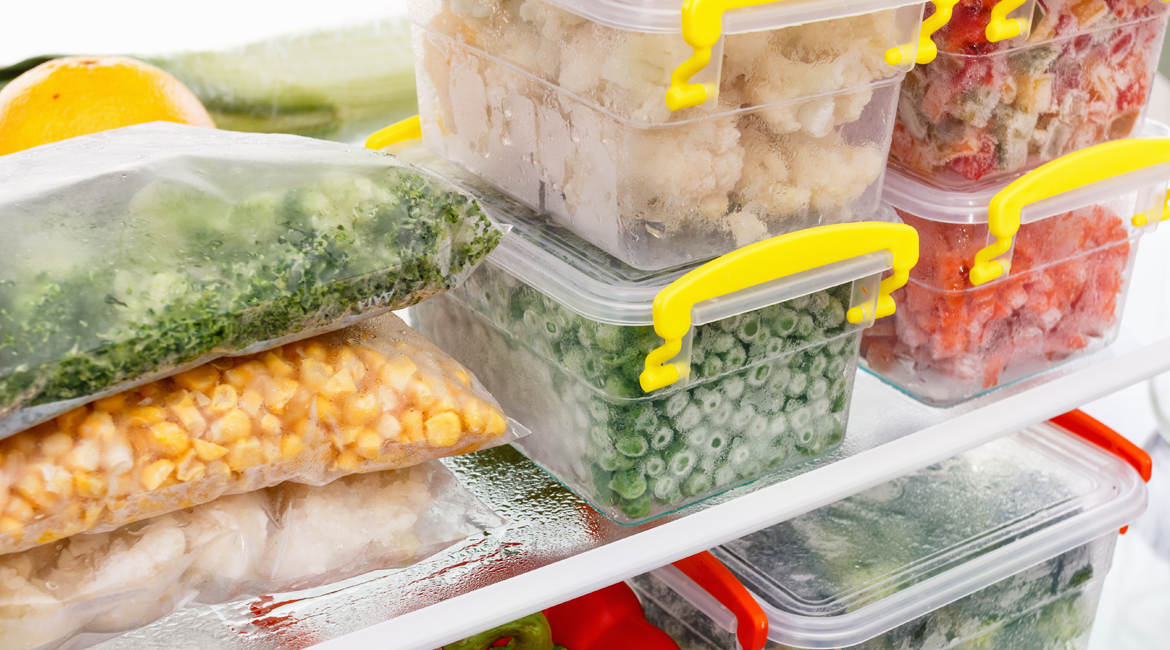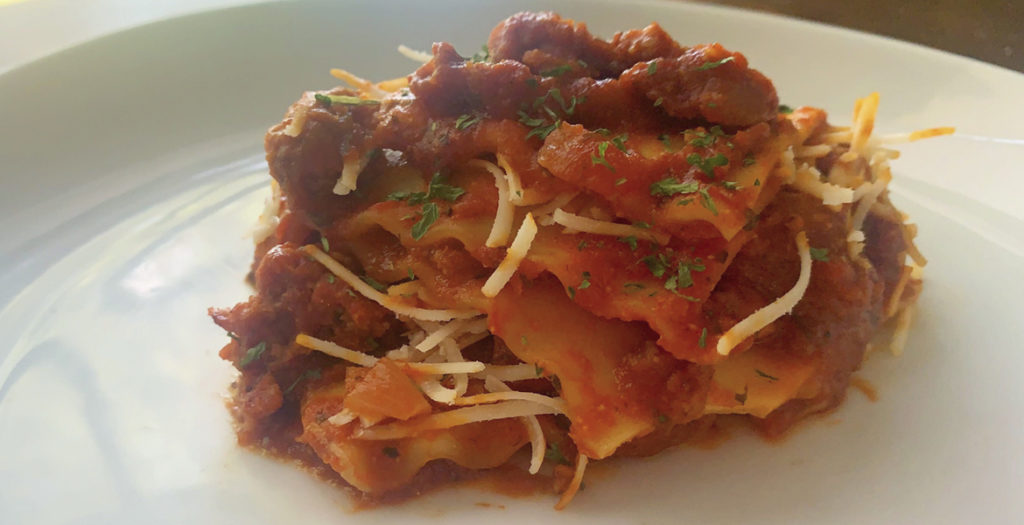7 Plant-Based Freezer Hacks to Make Meal Prepping a Breeze

In a time of a pandemic, saving what you can and using what is accessible has never been more important. But have you ever wondered what plant-based foods and staples you can freeze? Because so many plant-based foods are packed with water, you might be thinking that your plant food is doomed to freezer burn or mushy textures. Not so!
Most cooked plant-based foods can be frozen. Any raw fruit or vegetable with a high water content (celery, melons, apples, fresh leafy greens) should be kept out of the freezer unless you’re using it for a smoothie. Plant-based dairy substitutes should be kept out of the freezer too, as they’re likely to separate. Cornstarch-thickened sauces will separate as well.
Other than those few, everything else can be frozen in some way! Plant-based proteins of all types hold up very well being frozen, and some even improve in texture! Here are 7 freezer tips from me to you so you can start prepping like a pro.
Bread
A store-bought loaf of bread can be frozen for up to three weeks and thawed in the refrigerator with no discernible difference. Homemade bread can be frozen by wrapping in plastic wrap and covering in foil after cooling completely. It will preserve this way for about six months, but try to use it sooner to avoid that famous freezer taste.
Beans
Did you know that cooked beans can be frozen? After cooking, let the beans drain in a colander and cool completely. Once cooled, you can transfer them to a freezer bag or multiple freezer bags for smaller serving sizes. Once frozen, the beans will last in the freezer for six months– be sure to add a date for easy keeping!
Nuts
Cashews, macadamias, almonds, walnuts, pecans, peanuts, hazelnuts and their flours should all be frozen. If you’re not going to use them right away, it’s a good idea to keep nuts in the freezer. Nuts have a significant amount of fat which can go rancid at room temperature. In the freezer, this process slows down immensely. Also, frozen nuts are very satisfying as a snack!
Tofu
Freezing tofu is a power move. The tiny ice crystals that form during the freezing process poke small holes. This makes it easier to press all of the water out when thawed, and makes the tofu even more absorbent of the sauce or broth that you’re adding it to. All you have to do is remove the tofu from its original container, cut it into slabs or cubes and store in a freezer bag. In the freezer, tofu will last about a month. Thaw and squeeze gently before using!
Seitan
I love making bite-sized seitan pieces for stir fries. Packed with protein and deceptively meaty, they make a great addition to plant-based hibachi plates, noodles, breakfast burritos and more. To freeze seitan, just portion out a cup or two per bag, remove the air from the bag and label with a date. Seitan can be used for up to three months after freezing.
Pasta & Pasta Water
As a multicultural and accessible staple, pasta is a dream to have already prepared and stored in the freezer. To prepare pasta for freezing, cook just under al dente. Undercooked pasta holds up in the freezer much better than cooked pasta. You’ll likely be using it in a sauce or broth later, so the pasta will finish cooking in that instead of water. Once you’ve finished making your pasta, you don’t have to stop there. Save that liquid gold from going down the drain and pop it into the freezer! The starches in the water make it great for improving the texture of gravies, soups, stews and sauces across the board. Just allow it to cool. completely before pouring into an ice tray for easy portioning.
Caramelized Onions
The sweet and savory flavor of caramelized onions makes any plant-based dish a party. Onions take a good while to truly caramelize- about an hour. However, it’s easy to do and even better when you make a big batch to save for later. I like to caramelize an entire bag of onions all at once, then store by packing the onions into an ice cube tray. To caramelize a bag of onions, slice or chop them, and grab a huge skillet. Add a couple teaspoons of oil and a very generous pinch of salt. Set your pan to medium-low heat and walk away. Use the timer on your phone to set a stirring alarm for every ten minutes. When you stir, scrape up the deliciousness and fold it back into the onions. As they get drier (35-45 minutes into the process), you can add a splash of balsamic vinegar or wine to continue deglazing the pan. Once browned and sticky, allow to cool and store in an ice tray. If any onions don’t fit into the ice tray, eat them on toast.

Freezer-Friendly Recipe: Lazy Lasagna
Now that you know the basics of freezer-friendly cooking, try out our favorite lazy lasagna. Make it ahead and enjoy for weeks to come!
Ingredients
- 1 box (16 oz) of lasagna noodles, boiled and cut into 2” wide strips
- 1 tbsp olive oil
- 1 small onion, chopped
- ½ lb – 1 lb of ground meat alternative (Beyond Meat, Gardein, Lightlife, beans, seasoned TVP, etc.)
- 2 tsp oregano
- 2 tsp basil
- ½ tbsp onion powder
- ½ tbsp garlic powder
- ½ tbsp mushroom powder (optional)
- 3 cloves of garlic, chopped
- 3 tbsp dry red wine (optional)
- (1) 24 oz jar of favorite pasta sauce
- Salt and white or black pepper, to taste
- Favorite plant-based parmesan or cream cheese (optional)
Instructions
1. In a large pot, bring generously salted water to a boil. Cook your noodles 1 minute less than is recommended by the package directions, and quickly remove from heat. Drain the noodles, saving 1½ cup of pasta water and setting aside. Be sure to not overcook your noodles! If they’re overcooked, they won’t survive the freezer.
2. In a large skillet set to medium heat. Add 1 tbsp of olive oil and 1 small chopped onion. Cook for 5 minutes, until onions are fragrant and translucent. Add ½ lb or 1 lb of your choice of ground meat alternative to the skillet and cook for 6 minutes, or according to the package directions. If you’re using a neutrally-flavored protein (such as tofu, beans or TVP) add a generous pinch of salt.
3. If you’re using red wine, add it to the add to deglaze the browned bits stuck to the pan. Add a jar of pasta sauce and reduce for 5-7 minutes. This concentrates the flavor of the tomato sauce and adds richness and depth. Remove from heat.
4. If you’re making this for later, you can stop here and freeze. Allow the noodles, pasta water and sauce to cool completely. Cut the noodles into 2” sections (4-5 for each noodle) and store in a quart-sized resealable bag. In another quart-sized bag, store the sauce. Store the pasta water in an ice tray to use for later (label it so no one gets a gross surprise later). Make the resealable bags as flat as possible and push out all of the air. Throw everything in the freezer.
5. When you’re ready for your lazy lasagna, allow the noodles and sauce to defrost on your countertop or in a bowl full of warm water. (If your bags are BPA-free and microwave safe, you can speed up the process using the defrost setting on your microwave. Check on it in 30 second increments.)
6. Once the bags are defrosted enough to release from the bag, pour the frozen contents of the sauce into a pot on medium heat. It will be thick, so add a few cubes (2-3) of pasta water to thin it out. Taste for seasoning adjustments. Make sure the sauce is warmed through before moving to the next step!
7. When the sauce is defrosted and lightly bubbling, add your mostly cooked noodles. Reheating them in the sauce will impart more flavor. The noodles should only take a minute or two to heat through. Turn off the heating element of your stove.
8. With a fork, fish out a lasagna noodle and spoon on the sauce, then top with a plant-based parmesan or a dollop of plant-based cream cheese. Repeat the layering twice. Serve and enjoy!
What's Next?
Looking for more tips? Grab our free Plant-Based Starter Guide for kitchen hacks, recipes and more, AND for access to our monthly newsletter.


